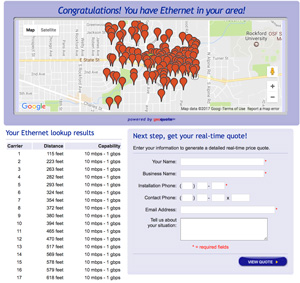By: John Shepler
Are you still dealing with slow internet service plagued by low speeds, network congestion, high latency, packet loss, or all of the above? It’s frustrating, right? You’re likely spending more on subpar service than you would on a high-performance fiber optic broadband upgrade. The question is: “Is business fiber optic internet available in my area?”
 Times Have Changed
Times Have Changed
When broadband first became an option, choices were limited. DSL was once the leading technology, with even basic ADSL shared connections offering a significant speed boost over previous options.
While expensive, T1 lines provided more stability and reliability, though speeds were limited to 1.5 Mbps, which was sufficient in the early days of e-commerce.
Many businesses relied on satellite connections to link retail locations with their main offices, accepting high latency and weather-related outages as unavoidable drawbacks.
However, this is all ancient history. Business operations have undergone a massive transformation in recent decades. The internet is no longer just for email and research; it’s the essential link to cloud services and global connectivity. There’s no reason to settle for inadequate internet service, especially when fiber optic internet might be readily available at a fraction of its previous cost.
Fiber Has Been Sneaking Up on You The truth is, fiber optic cables have been discreetly installed in urban and rural areas nationwide. It’s no longer headline news when a fiber optic cable is laid because it’s now considered basic infrastructure, much like gas pipes and power lines. You might even accidentally hit one while digging – a costly mistake.
Who’s Burying Fiber Cables Nearby?
Telephone companies are known for installing telecom infrastructure, including copper and fiber lines. They often own the existing copper lines but may not have the same level of ownership over fiber optic infrastructure.
While telephone companies are upgrading their systems to handle the increasing bandwidth demands of mobile data, cloud services, and video streaming, other players are also involved.
Cable companies, traditionally associated with coaxial cables, are also investing in fiber optic infrastructure. While they use coaxial cables within buildings, these often connect to fiber optic lines nearby, forming the backbone of their network. Recently, major cable companies have started offering fiber connections to businesses, providing high bandwidth, low latency, and minimal packet loss at competitive prices.
Independent network companies are another significant contributor to fiber optic infrastructure. They’ve established their own regional and national fiber networks, often bypassing telephone and cable companies to connect customers directly.
So, How Do I Get Fiber? While you could research providers yourself, you might overlook some of the best options, particularly those without a local presence or extensive advertising. Your best bet for finding the most comprehensive range of options at competitive prices is to use a bandwidth broker. These companies have connections with numerous service providers and access to service maps, allowing them to identify available services near your location. You might be surprised to learn that a neighboring building is already connected to fiber, making it simple to get you connected quickly.
Want to know if fiber optic internet is available for your business? Enter your address to see a map and list of fiber optic Ethernet broadband providers in your area. Then, use the inquiry form to describe your specific requirements and receive pricing and installation timeframes for the most suitable options.

